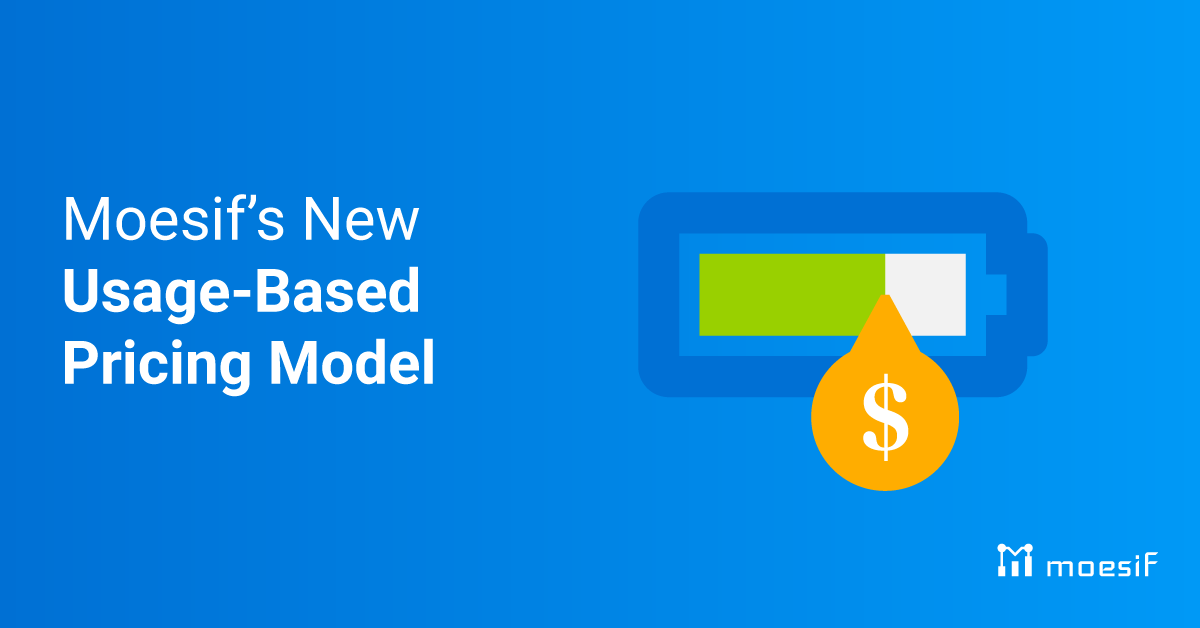Moesif’s New Usage-Based Pricing Model

This month at Moesif, we released a new usage-based pricing model for our platform. With these changes, we have brought in a new pricing scheme that is better aligned with customer value and requirements. In this article, we will walk through the history of pricing at Moesif and how we designed our latest pricing update, which is our third iteration.
History of Moesif Pricing
For many startups, pricing can become an afterthought as founders and operators focus on building and selling their latest and greatest products. However, nailing the right pricing can have an outsized impact on your growth. The right pricing can bring better value to customers and also help to fuel further product development. Recently, Moesif released our third iteration of pricing. How we moved through each iteration of pricing is important to see how we have landed at our new, most-optimal pricing yet!
When we first brought Moesif to market, we initially released it with fixed pricing. Then, after picking up some steam and customers, we layered in flexible quotas to those fixed pricing options. This month, we released a new pricing model designed to be even more flexible. The goal was to ensure that pricing is meeting customer needs and enabling our customers to scale their analytics in the most cost-effective manner. Let’s take a deeper dive into each of these pricing iterations.

Fixed Pricing Tiers
Like many SaaS startups, Moesif launched with simple, fixed pricing tiers. There was no usage-based pricing at that time, as with many very early-stage startups with limited engineering resources, the engineering investment was too high. At that time, usage-based billing platforms, like Moesif, did not exist yet to allow for easily implementing usage-based billing. This meant that usage-based pricing would require building a custom, in-house solution that could handle accurate metering of usage, a system to reconcile usage back to revenue, and auditable history of usage records. With these limitations in place, we created three self-service tiers, each with a hard quota being enforced. These plans, as some will remember, looked like this:
- A free plan to pilot Moesif without requiring a credit card.
- A growth plan for individual users at early-stage startups. ($100/mo)
- A pro plan for teams at scaling startups. ($550/mo)
As a company, we quickly realized this pricing model was too rigid to handle our customer’s requirements. In particular, customers would get locked out of their accounts even when going just slightly above their quota. Yet, the jump between tiers was harder to justify for many users due to a gap in perceived value. An individual user who barely exceeded their plan quotas had to pay over a 5x increase in their monthly price, from $100/mo to $550/mo, to jump to the next tier. These customers were typically in the discovery stage of launching a new API product and weren’t ready to upgrade. Thus, the old fixed tiers were inflexible and couldn’t support a variety of different customer sizes, each with varying maturities of their API products and varying event volume requirements. Even so, this was an important upgrade path for users since it was the critical transition point to move from an individual user to a team plan with multiple seats.
Fixed Pricing Tiers With Flexible Quotas
At this point, in the second iteration of pricing we set out to solve the gap between cost and perceived value and to avoid large cost jumps between tiers. Our solution was to roll out a new Pay-As-You-Go (PAYG) pricing strategy that would be added on top of our fixed tiers. This enabled a customer who is slightly above their quota to have the ability to stay on their plan and increase usage without getting locked out of their account. Additional events beyond the plans quota were simply billed as they were being used via the new Pay-As-You-Go capabilities. A customer whose event volume was between our Grow and Pro tiers could pay a price that landed somewhere in between the two tiers without having to upgrade. Adding this ability greatly improved our pricing to match customer requirements. This iteration remained in place for a while, However, we were not done with optimizing our pricing to deliver the best value for our customers.
What’s Wrong With The Old Pricing?
Our fixed + Pay-As-You-Go pricing model was an interim solution since we still had the rigid tiers but could now handle overages without a forced upgrade. Even with the addition of the Pay-As-You-Go component, since it was “added on” to the existing fixed tiers, some customers were still limited in the flexibility of our pricing. Overall, customers were happy with the new pricing models and as more customers came on board we were able to gather more feedback and data to optimize pricing even further. With the data and feedback gathered over the last year, we started to recognize some gaps in our existing pricing model and began to rally together to optimize our offering even further. Below we go over some of the factors that led to our latest pricing updates.
Overages Were Penalized
Since we left the pricing of the tiers the same in the last update (Free, Grow, and Pro), any additional events beyond the quota were billed as an overage. While normally this isn’t an issue if the overage volume is a fraction of the plan quota, we started seeing customers with larger projects deploying Moesif on a self-service plan. Unfortunately, the largest commitment level on self-service was still the Pro plan. If customers wanted to commit to a larger volume to gain volume discounts on anything larger than a Pro plan, they were required to sign up for an enterprise plan. This didn’t always make sense since some customers were not ready for an enterprise-level commitment. This penalized customers who got a ton of value from Moesif and wanted to use Moesif to capture and analyze events from additional APIs and apps. Because of these factors, in these cases, our pricing was not aligned with our and our customer’s goals. In addition, a customer was unable to gain any discounts (such as an annual upfront discount) on any overage since they were always billed in the following month, in arrears.
Hard to Gain Value on The Smallest Plans
While our old Pro plan had a full year of data retention, our Grow plan had only 90 days of data retention. While this might be fine for a new user testing out Moesif on a new project, it’s not enough for someone serious about leveraging Moesif for business analytics and monetization in the longer term. For instance, some finance teams required the ability to measure usage for the last quarter and product teams wanted the ability to measure month-over-month and quarter-over-quarter. In these cases, these teams were limited on data retention of the Grow plan. Thus, the smaller plans were too limiting to demonstrate real value for customers who required the ability to look back at the history of usage in their platform within Moesif.
Redundancy Between Tiers
Besides the quota difference, the Grow and Pro plans had almost the same functionality except for a small set of features that initially had higher support costs. These more expensive features (which included retention analysis, chart downloads, and embedded dashboards) were initially launched on Pro to ensure we could support all customers with our highest level of support. Over time, we gathered enough feedback to reduce the cost of supporting those features. By improving the ability to support these features, the cost to support customers on a Grow plan became roughly similar to the cost to support customers on a Pro plan. Because of this, having two plans for roughly the same functionality introduced unnecessary pricing complexity. We believe that pricing should be easy to understand and predict. This has become a driving factor, the opportunity to remove complexity and make pricing easier to understand for new and existing customers.
Moesif’s New Flexible Pricing
With the latest update to pricing, there were three goals we wanted to achieve:
- Reduce the complexity in pricing by removing unnecessary/overlapping plans
- Ensure customers are not penalized for increased usage
- Ensure value can be gained on even the smallest plans
Moesif’s new pricing was launched in May 2023 to achieve these three goals. Let’s go into more detail on each of these factors which are outlined further below.
Reduced Complexity With a Single Self-Service Plan
The old Grow and Pro tiers have been merged into a single tier we have now called Growth. Having a single tier helps to greatly simplify pricing. The new plan provides access to all the original features on our previous Pro plan but with lower introductory prices. Instead of trying to decipher complex plan comparisons, the only difference a user needs to decide on is how many monthly events to commit to which makes plan selection and cost much easier to plan for. This means Moesif now has only three tiers:
- A Free tier for hobbyists and small projects.
- A self-service Growth tier for startups and medium-sized companies.
- An Enterprise tier for customers with more complex needs.
Avoid Overages Via Flexible Commitments
Instead of being hit with overage fees, the new unified Growth tier introduces the concept of “commitment levels”. This enables a customer to commit to higher event quotas and save on per-unit pricing as their needs and usage grow. For example, committing to 300k events monthly costs $1.8 per 10k events, but when committing to 5 million events per month, the unit cost drops to $1.42 per 10k events. Thus, users are encouraged to leverage Moesif more without getting penalized, a win-win solution. Previously, customers who went above the included 5 million events on Pro had two options: pay overages or upgrade to the enterprise tier. With this being the only option, there wasn’t a way to scale within the current Pro plan they were on. Now, with the latest Growth tier, you can choose whether to commit monthly or annually (which includes a discount) depending on your budget and needs. In addition, the annual discount is now expanded as it applies to the full commitment level. Previously, overage fees above the Pro plan quota were considered monthly and therefore not eligible for annual discounts.
A New, Generous Introductory Price
The smallest introductory Moesif plan now starts at $60/month while providing access to all features previously offered only on the Pro plan. Previously, if a customer required access to a feature available only on the Pro plan or wanted a year of data retention, they would have to pay $550/month even if their volume requirements were too low to justify the cost. The new Growth plan enables customers to leverage all of the features previously on Pro, but with a lower intro price of only $60/month. This helps new users get to their “aha!” moment more quickly without requiring a large commitment upfront, a hallmark of bottoms-up adoption. All Growth customers also benefit from a full year of data retention, regardless of their commitment level. This ensures you’re able to report on long-term product and business trends without fear of premature deletion of your user’s usage data.
What About Existing Customers?
Ensuring existing users are not impacted by pricing changes is critical for any SaaS product. When a customer signs up for a service like Moesif, they expect to pay the price at that time. Because of this, all existing customers have been grandfathered on their current plans as long as they keep their paid subscriptions active. For some customers, it may make sense to stay on their existing plan, others may want to take advantage of the new pricing model. Contact us today to chat with us about your existing plan or sign up to try out Moesif and experience our latest pricing for yourself!





